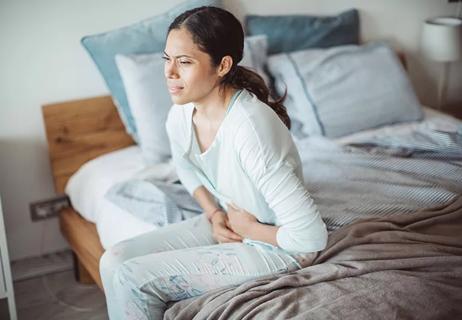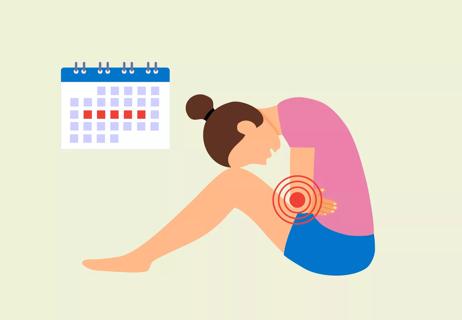Endometriosis pain occurs where the disease develops in your body

Endometriosis is a common health condition that the World Health Organization (WHO) says can affect up to 190 million women and girls of childbearing age. Anyone with a uterus can develop this often debilitating, painful condition.
Advertisement
Cleveland Clinic is a non-profit academic medical center. Advertising on our site helps support our mission. We do not endorse non-Cleveland Clinic products or services. Policy
“Endometriosis is a chronic inflammatory disease,” says Miguel Luna, MD, Director of Endometriosis at Cleveland Clinic’s Ob/Gyn and Women’s Health Institute.
Endometriosis can complicate your chances of getting pregnant, although the most common symptom is a painful period, or dysmenorrhea. A 2015 study focused on adolescents diagnosed with endometriosis found that 64% had painful menstrual cycles.
“Once you start having periods that require pain medicine, require staying home from school, staying home from work, that is the first sign that we should investigate further,” says Dr. Luna.
In addition to significantly painful periods, the “other telltale signs of endometriosis are painful sex and painful defecation,” says Dr. Luna. “We say these symptoms are a triad. Having them together significantly increases the likelihood you have endometriosis.”
Your uterus contains a special kind of glandular tissue that’s responsive to changes in estrogen and progesterone. As a result, you shed this every month during a menstrual cycle as your hormones fluctuate.
With endometriosis, a similar type of hormone-sensitive tissue develops outside of your uterus. “However, this tissue still grows and sheds every month,” explains Dr. Luna. “This can cause scarring and inflammation because the tissue is growing on a surface that does not tolerate monthly growth and shedding like the uterus does.”
Advertisement
In some cases, endometriosis can lead to scarring in your peritoneal lining, which is located on the inside of your pelvis and abdomen. In more serious cases, endometriosis can develop in your ovaries, fallopian tubes or even your intestine.
Dr. Luna notes that endometriosis scarring can also lead to existing tissue sticking to other tissue. “For example, the rectum becomes stuck to the backside of the uterus because of this scarring and constant scarring. That can cause pain in people.”
You feel endometriosis pain where the disease develops in your body. That’s why painful periods are so common. “If the endometriosis is in the pelvis, it will create pelvic pain,” explains Dr. Luna. “This pain is associated with — and worsens during — your menstrual cycle. As time goes by, you’ll feel pelvic pain even outside of your period.”
Although pelvic pain is common with endometriosis, with certain types you might feel pain in your:
This pain is a clue to where endometriosis has developed. “For example, if you have endometriosis present on your right ovary, you might have more pain on your right side,” says Dr. Luna. “If there’s an endometriosis lesion on your bowel, rectum or the sigmoid colon, you’ll have pain and sometimes bleeding when you poop.”
Endometriosis pain also depends on the severity of the disease. In fact, there are different types of endometriosis. Superficial endometriosis develops on the surface of tissues in your abdominal area. However, deep endometriosis infiltrates and affects other tissues or organs, while ovarian endometriosis is found in your ovaries.
“Ovarian endometriosis does tend to get worse over time because it’s a cyst and it fills up with fluid and continues to grow,” says Dr. Luna, while adding that other types of endometriosis can worsen as they become resistant to medicine. “For example, if you’re taking birth control pills or progesterone for a very, very long time, at some point in time, these implants do become resistant and you’ll feel pain.”
Dr. Luna also notes that doctors haven’t necessarily seen someone with superficial endometriosis have their condition progress into deeper endometriosis. “We believe that they’re all different,” he explains. “Superficial is different than the deep kind — and the deep kind is different than the ovarian type.”
Identifying endometriosis is easier than it used to be because more doctors are recognizing pain as a major symptom.
“Today, we’re moving towards evaluating you clinically, with signs and symptoms, and using imaging to diagnose endometriosis,” Dr. Luna says. “If you come to my office with painful periods and painful intercourse, with pain in the back part of your uterus, we’ll order an MRI. We can see the lesions on the ovary and the deep lesions on the posterior side of your uterus. And then, we’ll already know that we have a diagnosis of endometriosis.”
Advertisement
In the past, detecting endometriosis was more complicated, and depended on a diagnostic laparoscopy and a tissue biopsy. Dr. Luna says this often led to some people taking years to be diagnosed. But being able to avoid the operating room and biopsies means your endometriosis can be identified sooner.
If you suspect you might have endometriosis, it can help to try to zero in on why you think so. Be as detailed as possible, especially when describing your pain.
“If you’re having painful periods, describe how these periods are painful,” encourages Dr. Luna. “And share any pain association you might feel.” For example, if you have painful urination or painful bowel movements during your menstrual cycle — or blood in your urine or stool — mention this to your doctor.
To figure out how to explain endometriosis pain, it can help to write down what you feel. “Having a good symptom log is very, very important,” says Dr. Luna. “And then also let your doctor know that you want to know whether you have endometriosis. Be very, very clear and blunt about that.”
Once you receive an endometriosis diagnosis, Dr. Luna says treatment is tailored toward your goals. “Is it pain relief? Is it fertility? Is it having a baby in the next year?” he says. “It’s very patient-centered and patient-based.” As a result, treatment for endometriosis varies and is highly individualized.
Advertisement
Treatment can include medical or surgical approaches. “The medical management of endometriosis is hormonal suppression, birth control pills, progesterone and other medicines,” Dr. Luna says. “Surgical treatments involve excising (removing) endometriosis lesions.”
Some people with endometriosis can find pain relief with nonmedical and nonsurgical approaches. “People with endometriosis can have many types of pain, depending on where they are in their journey with the diagnosis,” Dr. Luna explains. “They could already have a diagnosis of chronic pelvic pain. But keeping a healthy lifestyle, exercising regularly, doing yoga to strengthen your pelvic floor, relaxation techniques — all of these things are helpful.”
Changing your diet can also be helpful.
“There’s actually no data for us to actually steer the patients into one specific lifestyle or the other,” says Dr. Luna. “You might find that a vegan diet is better. Some patients are on a Keto diet and feel much better. It varies.”
If you’ve found a good groove to relieve endometriosis pain, Dr. Luna says it’s OK to keep going. “If you’re trying acupuncture and going to yoga and it’s working for you, then please go ahead,” he says. “If pelvic floor physical therapy or other types of physical therapy, or meditation techniques, are working, that’s fine. We encourage you to keep on doing whatever’s working to make you feel better.”
Advertisement
At the end of the day, being diagnosed with endometriosis can lead to improved treatment options — and help you live a more pain-free life.
“Endometriosis is a debilitating disease,” says Dr. Luna. “It’s detrimental to your quality of life and sexual health. If patients are in pain for a very, very long time, they have issues with fertility and conception. Quality of life scores in patients with endometriosis have been compared to patients with cancer, and they’re similar. It’s a very important diagnosis to have so treatment can improve your life.”
Learn more about our editorial process.
Advertisement

The most comfortable sex positions minimize deep penetration

Food is medicine when you’re dealing with endometriosis

Vaginal pain can be caused by infections, cysts or other conditions

5 things to know about the signs of endometriosis

Endometriosis, pelvic floor dysfunction and bladder issues can all contribute, but relief is within reach

Developmental changes like puberty and menopause can impact symptom severity

They can happen whether you’re having a period or not

From medications and stress to PCOS and STIs, there’s a wide range of reasons Aunt Flo may overstay her welcome

Type 2 diabetes isn’t inevitable with these dietary changes

Applying a hot or cold compress can help with pain